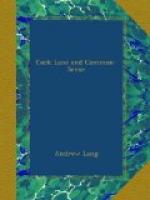As we began by stating, it is a popular superstition among the learned that the belief in second sight has died out among the Highlanders. Fifty years ago, Dr. McCulloch, in his Description of the Western Islands, wrote thus: ’Second sight has undergone the fate of witchcraft; ceasing to be believed, it has ceased to exist’. {245} Now, as to whether second sight exists or not, we may think as we please, but the belief in second sight is still vivacious in the Highlands, and has not altered in a single feature. A well-known Highland minister has been kind enough to answer a few questions on the belief as it is in his parish He first met a second-sighted man in his own beadle, ’a most respectable person of entirely blameless life’. After citing a few examples of the beadle’s successful hits, our informant says: ’He told me that he felt the thing coming on, and that it was always preceded by a sense of discomfort and anxiety. . . . There was no epilepsy, and no convulsion of any kind. He felt a sense of great relief when the vision had passed away, and he assured me repeatedly that the gift was an annoyance rather than a pleasure to him,’ as the Lapp also confessed to Scheffer. ’Others who had the same gift have told me the same thing.’ Out of seven or eight people liable to this malady, or whatever we are to call it, only one, we learn, was other than robust, healthy, and steady. In two instances the seers were examined by a physician of experience, and got clean bills of mental and bodily health. An instance is mentioned in which the beadle, alone in a boat with a friend, on a salt-water loch, at night, saw a vision of a man drowning in a certain pool of a certain river. A shepherd’s plaid lay on the bank. The beadle told his companion what he saw, and set his foot on his friend’s, who then shared his experience. This proves the continuity of the belief that the hallucination can be communicated by contact. {246} As a matter of evidence, it would have been better if the beadle had not first told his friend what he saw. Both men told our informant next day, and the vision was fulfilled ‘scarcely a week afterwards’. This vision, granting the honesty of the seers, was a case of ‘clairvoyance,’ but ‘symbolical hallucinations’ frequently occur. In our informant’s experience the gift is not hereditary.




